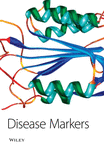Peptides in Low Molecular Weight Fraction of Serum Associated with Hepatocellular Carcinoma
Abstract
The incidence of hepatocellular carcinoma (HCC) in the United States is increasing and the increase is projected to continue for several decades. The overall survival of HCC patients is poor and treatments are not effective in part because most of the diagnoses come at a late stage. The development of new markers for detection of HCC would significantly improve patient prognosis. This paper describes identification of candidate markers previously reported in our serologic study of an Egyptian population by quantitative comparison of matrix assisted laser desorption ionization time of flight (MALDI-TOF) mass spectra. To identify these marker candidates, we performed LC-MS/MS sequencing that identified nine native peptides associated with HCC, including two reported previously. Four truncations of N terminus of complement C3f and a fibrinopeptide increased in control sera; two complement C4α peptides, a zyxin peptide, and a coagulation factor XIII peptide increased in cancer patient sera. We have also identified increased biliverdin diglucuronide in the sera of cancer patients. These peptides could potentially serve as markers of HCC following additional validation studies; however, association of similar peptides with other diseases and cancers dictates a very cautious approach.




